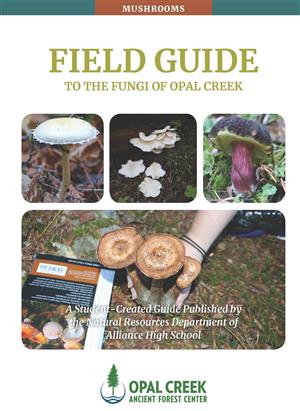-
Alliance at Meek students combine science and media skills to produce book
4/15/2019The question at the heart of the book created and published by students at Alliance High School at Meek is simply: “Can I eat it?” The book, “Field Guide to the Fungi of Opal Creek,” was a collaborative effort between the school’s science and media wings.
The book shows and describes 34 mushroom species found in the Opal Creek Scenic Recreation and Wilderness Areas, located in the Willamette National Forest. It combines the knowledge and skills learned by students under Joe Ferguson, who teaches Natural Resources, and Amy Taramasso, who teaches Digital Media.
Each mushroom is shown in vivid photos, most taken by Alliance students, and described in text written by students, who thoroughly researched each fungi. At the top of each entry is the big question: is the mushroom edible? The answers are varied. For example:
Flat-Top Club Coral: “Yes, it has a sweet flavor and can used in sweet or dessert dishes.”
False Morel: “No! It is deadly poisonous – in fact, it contains gyromitrin, an unstable compound that hydrolyzes into monomethylhydrazine, a compound used in rocket fuel.”
"We were really cognizant of the fact that mushrooms are both really interesting and can be really dangerous,” Taramasso said. “We were very careful with our work.”
 Ferguson had taken his students to Opal Creek for years, and in a conversation with Megan Selvig, an Opal Creek director, learned that there was a professionally-produced guide about amphibians in the area, but not one about fungi. At a summer training at Meek, he raised the idea with Taramasso about using a grant the school had received for project-based learning to produce a book.
Ferguson had taken his students to Opal Creek for years, and in a conversation with Megan Selvig, an Opal Creek director, learned that there was a professionally-produced guide about amphibians in the area, but not one about fungi. At a summer training at Meek, he raised the idea with Taramasso about using a grant the school had received for project-based learning to produce a book."Joe said, ‘I can bring the science expertise if you can bring the publishing and layout and graphic and visual media piece,’” Taramasso said. “I said that sounds terrifying and exciting and really ambitious, but I'm in.”
Planning took place over the summer, and after the students received training, the group went to Opal Creek to find the fungi. Staff there helped with identifying mushrooms to photograph and to take back to the class for inspection and identification.
One challenge was that October was a drier-than-normal month, so the forest wasn’t wet enough for all fungus to grow enough for students to photograph. That forced them to go to outside sources for photos, an intended learning opportunity.
“That was a really great experience for the kids because I got to teach them about fair use and copyright,” Taramasso said. “It was the best opportunity I've ever had to teach students about copyright. It's integral to digital media, making sure that you're using things appropriately.”
The project became important enough to students that one, Ace Swanson, who had already earned enough credits to graduate, came back in the fall to help lay out and complete pages.
The school published an initial run of 250 copies as a first edition, and Taramasso said she and Ferguson hope to create future editions with more entries, and possibly get it co-branded with Opal Creek so it can be sold at its Forest Center.
Students who worked on the book were Natalie Mindra, James Ericson, Suley Vazquez, Arturo Garcia-Gonzalez, Viridiana Garcia-Olvera, Bear Slates, Kayla Ford, Jeremy Bowen, Zach Kelly, Torense Weldon, Aurora Rose, Will Morrison and Ceanna Beavers. Seng Saechao, an employee of Oregon State University’s Urban 4-H program and a community partner at Alliance at Meek, helped with photos.
By Month
- June 2025
- May 2025
- March 2025
- February 2025
- January 2025
- October 2024
- September 2024
- June 2024
- May 2024
- April 2024
- March 2024
- February 2024
- January 2024
- December 2023
- November 2023
- October 2023
- September 2023
- August 2023
- June 2023
- May 2023
- January 2023
- December 2022
- November 2022
- October 2022
- September 2022
- August 2022
- July 2022
- June 2022
- May 2022
- April 2022
- March 2022
- February 2022
- January 2022
- December 2021
- November 2021
- October 2021
- September 2021
- August 2021
- July 2021
- June 2021
- May 2021
- April 2021
- March 2021
- February 2021
- January 2021
- December 2020
- October 2020
- September 2020
- August 2020
- July 2020
- June 2020
- May 2020
- April 2020
- March 2020
- February 2020
- January 2020
- December 2019
- November 2019
- October 2019
- September 2019
- August 2019
- June 2019
- May 2019
- April 2019
- March 2019
- February 2019
- January 2019
- December 2018
- November 2018
- October 2018
- September 2018
- August 2018
- July 2018
- June 2018
- May 2018
- April 2018
- March 2018
- February 2018
- January 2018
- December 2017
- November 2017
- October 2017
- September 2017
- August 2017
- July 2017
- June 2017
- May 2017
- April 2017
- March 2017
- February 2017
- January 2017
- December 2016
- November 2016
- October 2016
- September 2016
- August 2016
- July 2016
- June 2016
- May 2016
- April 2016
- March 2016
- February 2016
- January 2016
- December 2015
- June 2015



